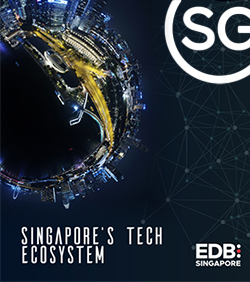Your one-stop guide to Singapore's Technology Ecosystem
Download your guide to expanding in Asia.

Singapore has long been hailed as Asia’s own Silicon Valley. The city-state’s implementation of several bilateral and regional free trade agreements, coupled with its digital and data-friendly policies, makes it an attractive place for tech businesses.
“What attracts a lot of companies and entrepreneurs to set up shop in Singapore are our sound fundamentals,” says Ang Chin Tah, senior vice president and head of government agency Digital Industry Singapore (DISG). “There’s a lot of predictability, and businesspeople like predictability. Their businesses are hard enough to run already without having to do additional guesswork.”
On top of that, rival city Hong Kong has been facing political unrest in recent years, leading more companies from the tech and finance sectors to shift their headquarters to Singapore due to its neutral position amid an increasingly polarized world.
However, there are still areas that the country has to work on.
Wanted: More tech talent
According to Sam Park, who heads Nanyang Business School’s Strategy, International Business, and Entrepreneurship division, Singapore’s lack of entrepreneurial talent could pose serious concerns for its innovative future.
While acknowledging that the city-state may have “some of the world’s leading engineering schools” in National University of Singapore and Nanyang Technological University, he also thinks it’s “not enough at all” to rely on this advantage. “Tech innovations nowadays pull knowledge and resources from many different sectors. Singapore needs to be able to produce a lot more excellent talent across many different sectors,” Park explains.
DISG’s Ang echoes this sentiment, saying that it’s true that companies find it difficult to hire the right people. However, he notes that this is the case not only for Singapore but also for tech capitals the world over.
“The good and bad news of it is that there’s not enough people everywhere – even in Silicon Valley they say there’s not enough,” Ang says. “So if there’s not enough anywhere, my job in government is to capture our unfair share.”
Attracting talent by attracting businesses
Singapore’s connectedness to both developed and emerging economies puts the country in the unique position of acting as a “launchpad” for multinational corporations (MNCs) seeking to enter Southeast Asia and for regional upstarts looking to access the global market. Ang says that the city-state can capitalize on this to draw more businesses from the regional and global markets.
“The growth MNCs from the West are looking for isn’t growth in Singapore per se, but growth in the region,” he observes.
Ang cites Google’s Next Billion Users initiative as an example of the role that the country can play in the ambitions of MNCs aiming to capture Southeast Asia. The Google project, which is run out of Singapore, plans to create products specifically for emerging markets.
Despite not having a billion users to offer the US tech giant, Singapore’s value is in its proximity and close ties to the countries within Google’s target market.
“Singapore is a jumping-off point,” Ang shares. “It’s a listening post for Google to better understand the needs of its next billion users.”
He adds that similarly, Southeast Asian tech players can treat Singapore as a “stepping stone” for their international endeavors. “It’s precisely because Singapore is English-speaking and cosmopolitan that they feel like it’s a great place to stretch their wings before they take flight into global markets.”

Download your guide to expanding in Asia.
By attracting businesses from across the world, Singapore is able to create “an interesting blend of East meets West,” forming a pool of global talent to supplement the hiring needs of the growing number of businesses – both local and foreign – setting up in the city-state.
“We want to connect all these businesses and people together so that they can find partnership, employment, and mentorship opportunities,” says Ang. He points out how this would set the local tech ecosystem flywheel into motion, turning it into “a virtuous cycle of opportunities, attracting talent, which improves the ecosystem, attracting more opportunities, which attracts more talent.”
Additionally, it’s not enough to “build economic bricks” and let the ecosystem grow on its own. Only when the synergies between local and foreign companies of all sizes are harnessed in complementarity can a tech ecosystem become healthy and vibrant.
“Singaporeans around the world will start working in the labs of Dell, Google, Facebook, or PayPal, but over time, some of them will naturally osmosize into the local ecosystem,” Ang explains. “They’ll start their own businesses, join our universities, maybe join the government, and teach us how to better develop policies and regulations around how to fund startups, develop rules around data privacy, and think about digital economy agreements.”
Learning from global tech markets
To ensure that Singapore remains an attractive place to do business, government agencies like DISG closely follow global innovation hubs such as Silicon Valley, New York, and London. However, Ang stresses that simply copying their policies and strategies wholesale wouldn’t work; instead, it’s vital that the country learns from what these leading tech ecosystems do right and then adapt best practices for the Southeast Asian context.
“We want to ensure inclusive, sustainable growth – growth that has a strong sense of social equitability.”
One aspect that the Singapore government has adopted is how Silicon Valley has enabled growth without telling companies how to run their business.
“We want to be very circumspect about the role of government in developing a tech ecosystem,” says Ang. “Nobody knows better than these companies about the vagaries of their markets and the strategies they need to adopt to win – we can’t advise them on that. The role we want to play is to build a strong set of enablers, whether that’s in making sure that policies are business friendly, looking at tax rates, or looking at the education system.”
However, he also makes it clear that the answer isn’t letting the tech ecosystem “grow completely laissez-faire.”
“We can’t have that in Singapore,” Ang says. “We want to ensure inclusive, sustainable growth – growth that has a strong sense of social equitability.”
Connecting the world’s tech nodes
Though Singapore is dubbed “the region’s tech hub,” Ang says he doesn’t like to use that phrase to describe the city-state.
“If we want to be a strong tech ecosystem, we need to be connected to other nodes,” he explains. “Our vision for Singapore is to be one of many innovative tech nodes, connected to Hangzhou, Shenzhen, Bangkok, Bali, London, Tel Aviv, and other places that are coming up.”
This is a necessary endeavor because businesses and individuals “flow from place to place, as and when they need to get the job done,” Ang notes.
“We shouldn’t be building up walls or setting ourselves apart from our neighbors,” he concludes. “We need to connect with the region and the world.”
Digital Industry Singapore is a joint office of the Economic Development Board, Enterprise Singapore, and Info-communications Media Development Authority.
Learn more about Digital Industry Singapore on its website.
This content was produced by Tech in Asia Studios, which connects brands with Asia’s tech community. Learn more about partnering with Tech in Asia Studios. This was originally posted here.